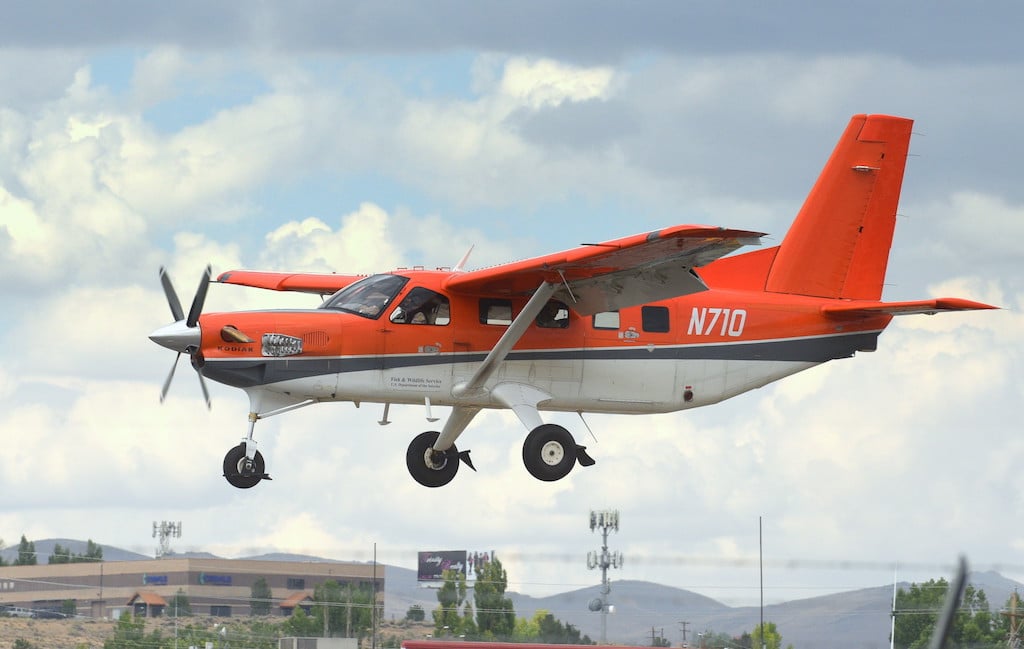
Bridger Aerospace operates four Kodiak 100s in the air attack role to fight wildfires.
Designed for and initially funded by mission aviation organizations to “reach the unreached” and “help spread the Gospel” in remote and underserved areas of the world, the Kodiak 100 has become popular with government and private operators for aerial firefighting, forestry, law enforcement, medevac and wildlife management applications.
In 1998, the Nampa, Idaho-based Mission Aviation Fellowship (MAF), a faith-based nonprofit group that provides aviation services to Christian and humanitarian organizations working in remote areas, helped the founders of Quest Aircraft develop the Kodiak 100 by raising seed money from other mission aviation groups. Profits from commercial sales of the Kodiak were to subsidize the cost of each 11th airplane produced, which then would be delivered to a participating nonprofit.
MAF took delivery of its first Kodiak 100 on March 19, 2009, and now reports operating 12 of the sturdy turboprops, along with Cessna 208 Caravans, 206s, 210s and 172s.
Among other Kodiak users, aerial firefighting company Bridger Aerospace operates four Kodiak 100s in the air attack role to coordinate other aerial resources battling wildfires. The Washington State Department of Natural Resources operates two for firefighting.
The U.S. Forest Service has two Kodiak 100s. The Florida Forest Service had received one, and a second aircraft was undergoing assembly at Daher Kodiak in Sandpoint, Idaho. State agencies in Louisiana, Maine and Missouri had either received Kodiaks or were awaiting delivery.
Paul Carelli, Daher Kodiak director of flight operations for North America, says the reliability and relatively low operating costs of the Kodiak make it attractive to the general aviation and government agency markets.
“Operating costs are really low on this aircraft, probably the lowest [for a] high-wing turboprop,” Carelli says. “Governments have fixed annual budgets, so they’re very aware of what they can spend, and Kodiak fits that niche well.”
Migratory Bird Surveys

The U.S. Interior Department operates eight Kodiak 100s, seven of which are flown by a constituent agency, the U.S. Fish & Wildlife Service (FWS), and one by the Bureau of Land Management.
The FWS uses Kodiak 100s to conduct low-level, continental surveys of migratory bird populations, generating data that informs both hunting and habitat-management decisions. The surveys are conducted with human observers. Though the agency has integrated camera and remote-sensing technology in its operations, it faces a challenge in processing the vast amount of data those sensors collect, says Mark Koneff, chief of the FWS branch of Migratory Bird Surveys.
Koneff spoke to BCA from Labrador, Canada, where he was participating in a continental waterfowl program involving a dozen aircrews from the FWS, aircrews from the Canadian Wildlife Service and ground support crews from both agencies. The FWS conducts migratory bird surveys low and slow; this one was being flown at 150 ft. above ground level and about 90 kt. airspeed.
“The 100s meet most of our needs, far better than a lot of the aircraft we used historically for these missions—aircraft like Cessna 206s, where we had some really severe weight and performance limitations,” he says.
All people in his branch are both pilots and wildlife biologists, says Koneff, who has logged 2,900 hr. on the Kodiak 100.
“As a pilot-biologist I’m flying the airplane and counting out the left side and we have a biologist observer counting out the right side,” he explains. “We record right into our mics. [The information] goes into a small computer in the airplane that’s also getting a GPS feed, so the positional locations are saved with the recordings. We have software we use back in the hotel or back in the office to transcribe all that data into text files that we send to our analysts in Patuxent, Maryland, who generate population estimates.”
The short-takeoff-and-landing capability of the Kodiak 100, the reliability of the PT6 turboprop engine and relatively low operating costs are pluses for the environment in which the FWS operates, Koneff says. The Kodiak is also a good instrument flight rules platform for long-distance ferry flights, he says, and its float compatibility is useful in areas where pilots may need to land on water to wait out the weather.
“We also have two Cessna 206G [piston singles], one on amphibious floats the other on wheels,” Koneff says. “They have their niche. But for higher-risk marine surveys, we’re single-engine, so we rely on the turbine as a mitigation strategy.”





